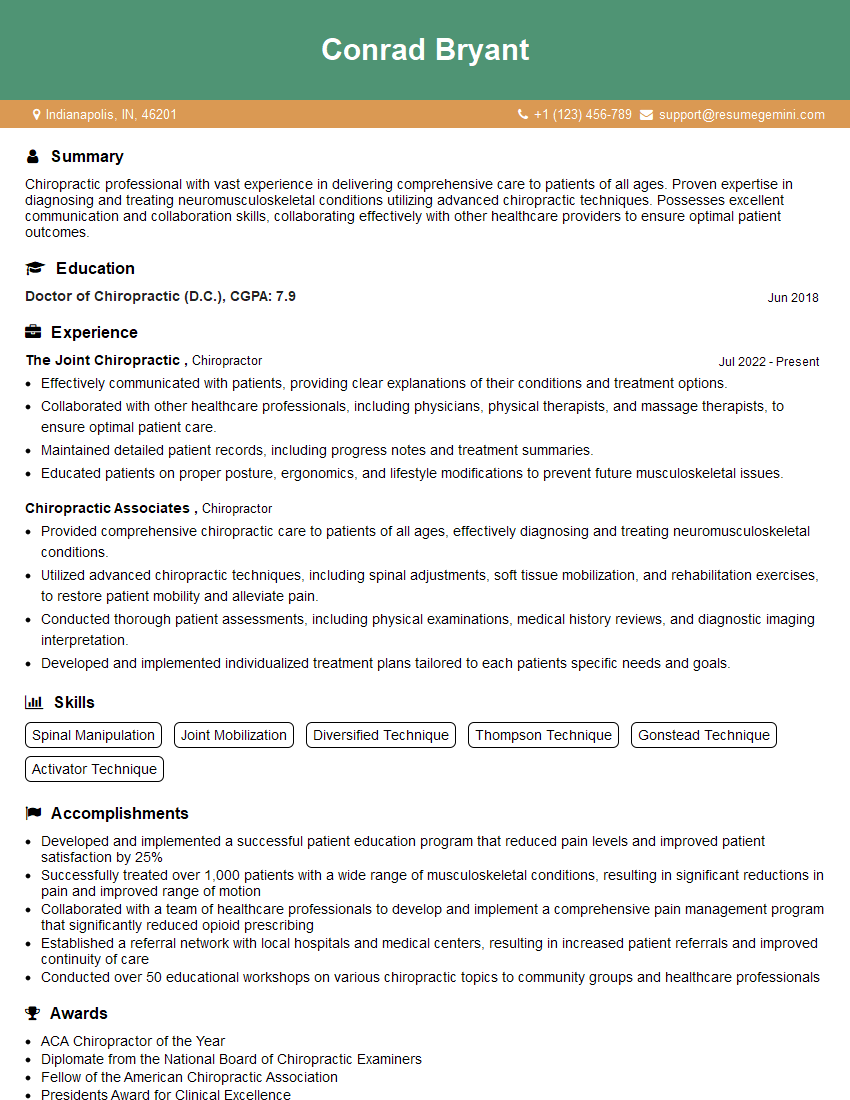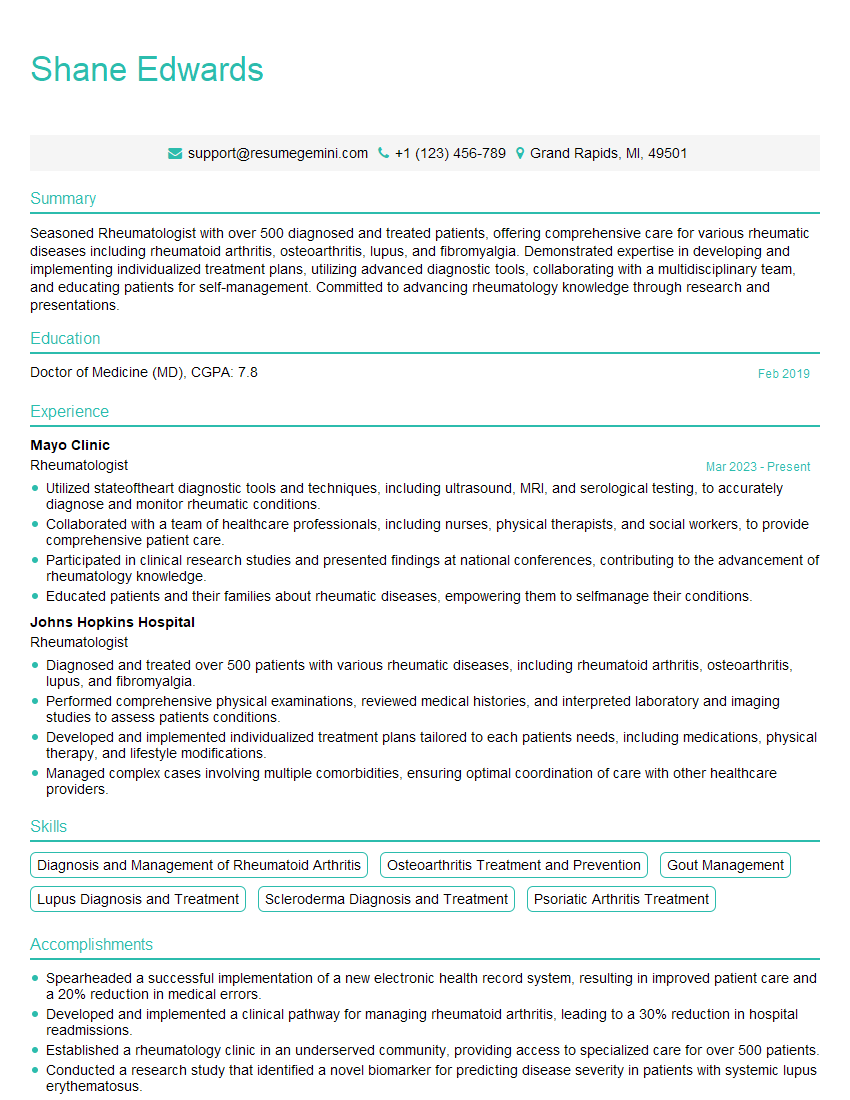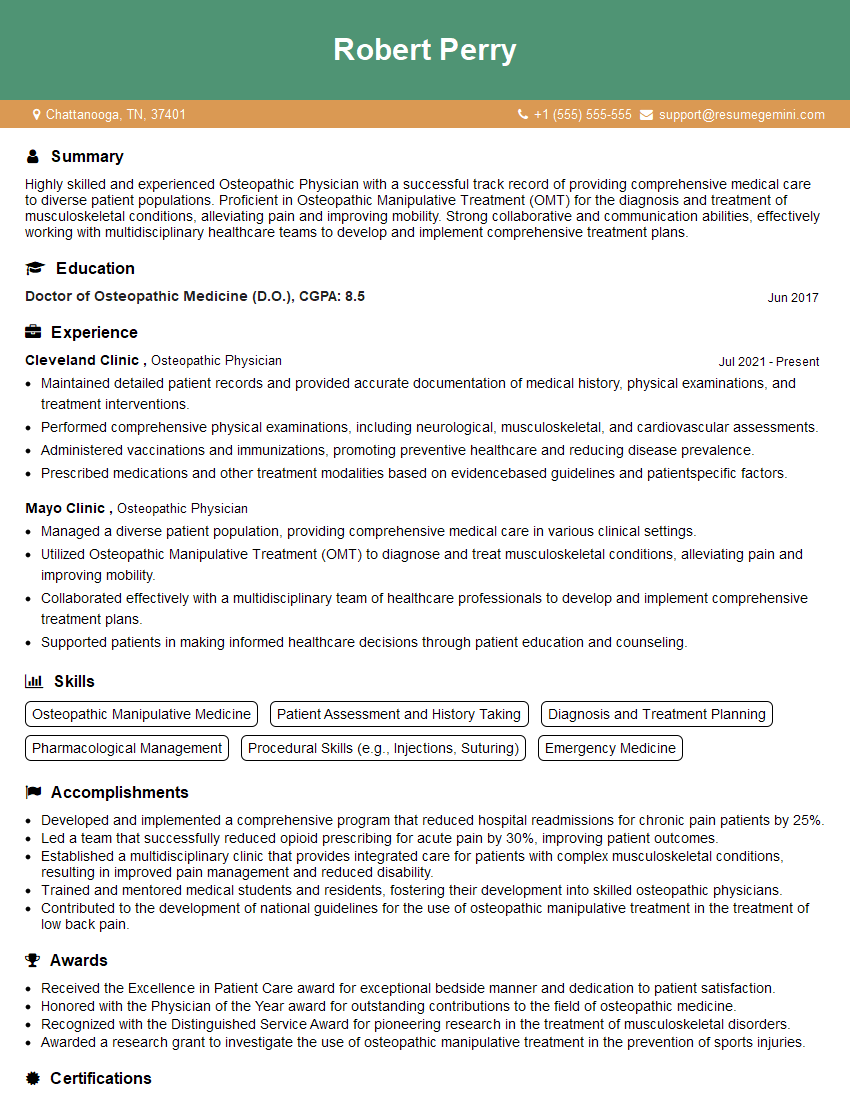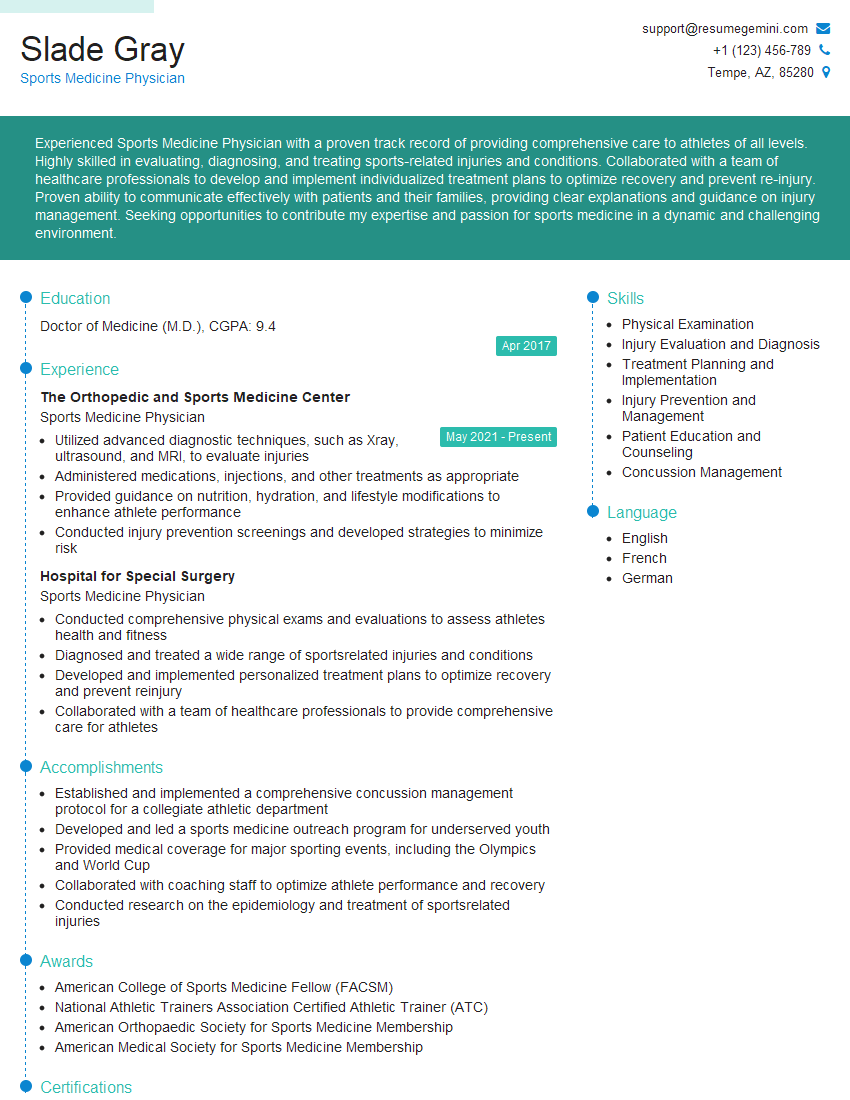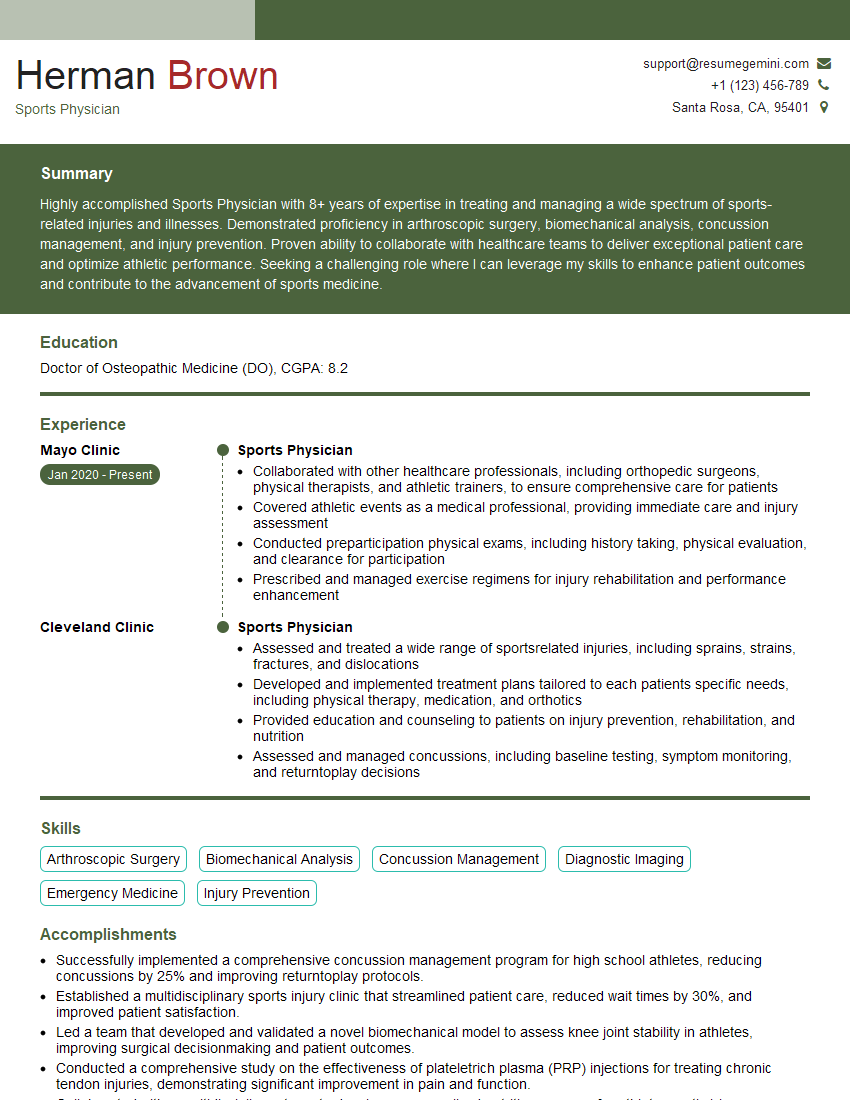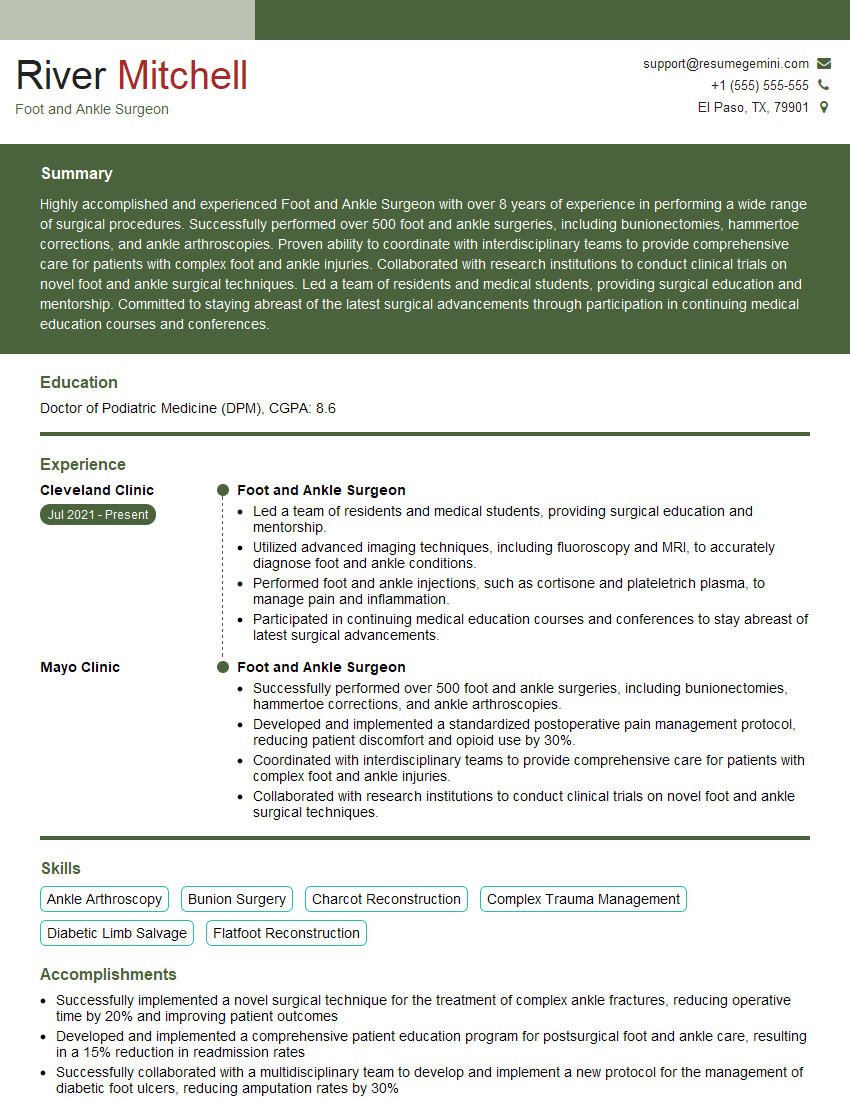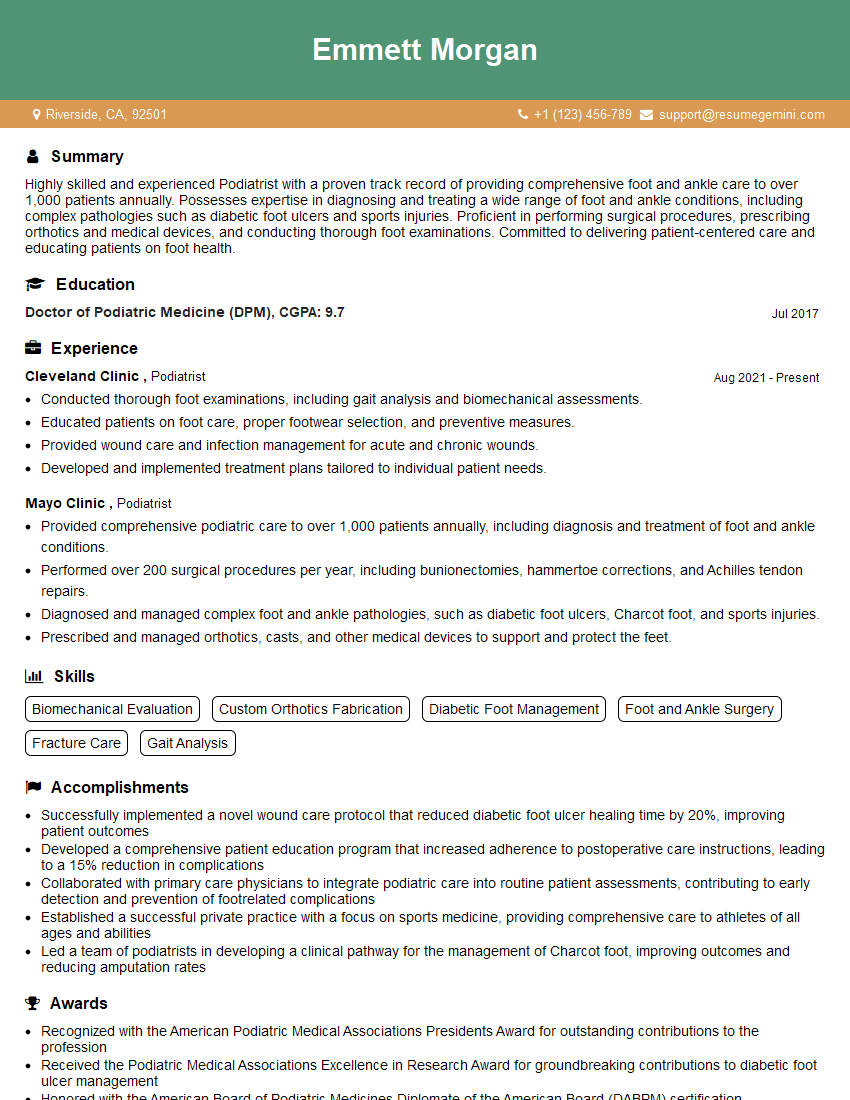The thought of an interview can be nerve-wracking, but the right preparation can make all the difference. Explore this comprehensive guide to Heel Pain Management interview questions and gain the confidence you need to showcase your abilities and secure the role.
Questions Asked in Heel Pain Management Interview
Q 1. Describe the common causes of plantar fasciitis.
Plantar fasciitis, the most common cause of heel pain, arises from inflammation of the plantar fascia, a thick band of tissue on the bottom of your foot that runs from your heel to your toes. Think of it as a strong bowstring supporting your arch. Overuse, improper footwear, and certain foot mechanics are key culprits.
- Overuse: Activities like prolonged standing, running, or high-impact exercise repeatedly stress the plantar fascia, leading to microtears and inflammation.
- Improper Footwear: Flat shoes or high heels offer little arch support, placing excessive strain on the plantar fascia. Imagine a bowstring without a bow – it’s under constant tension.
- Foot Mechanics: Conditions like flat feet (pes planus), high arches (pes cavus), or excessive pronation (inward rolling of the foot) can increase stress on the plantar fascia. Picture a poorly balanced bridge – it’s more likely to collapse under pressure.
- Obesity: Excess weight increases the load on the plantar fascia.
- Tight Calf Muscles: Tight calf muscles can pull on the heel bone and increase plantar fascia tension.
Q 2. Explain the differential diagnosis of heel pain.
Heel pain has a broad differential diagnosis, meaning many conditions can mimic plantar fasciitis. Accurate diagnosis is crucial for effective treatment. Key considerations include:
- Plantar fasciitis: As discussed, the most common cause, typically characterized by pain at the heel’s bottom, worse in the morning or after rest.
- Heel Spur: A bony outgrowth on the heel bone, often associated with plantar fasciitis but not always causing pain itself.
- Achilles Tendinitis: Inflammation of the Achilles tendon, causing pain behind and above the heel, often worse with activity.
- Stress Fracture: A small crack in the heel bone, typically caused by repetitive impact, causing sharp pain localized to a specific area.
- Sever’s Disease: A childhood condition affecting the heel’s growth plate.
- Retrocalcaneal Bursitis: Inflammation of the bursa behind the heel bone, causing pain and swelling.
- Nerve Entrapment: Conditions such as tarsal tunnel syndrome can cause heel and foot pain.
- Plantar Fibromatosis (Ledderhose Disease): A noncancerous growth of the tissue under the foot, causing a hard lump.
A thorough history, physical examination, and potentially imaging studies are necessary to determine the precise cause of heel pain.
Q 3. What are the key physical examination findings in a patient with heel pain?
A thorough physical exam is essential. I’d assess:
- Palpation: Gently pressing along the plantar fascia to identify tenderness. Pain at the medial heel is highly suggestive of plantar fasciitis.
- Range of Motion: Checking ankle and foot flexibility. Tight calf muscles often accompany plantar fasciitis.
- Gait Analysis: Observing how the patient walks to identify any abnormal foot mechanics. Overpronation is a common finding.
- Neurological Examination: To rule out nerve entrapment.
- Palpation of the Achilles tendon: To assess for tenderness suggestive of achilles tendinopathy.
I’d also ask the patient about the pain’s location, intensity, duration, and any aggravating or relieving factors. For example, does the pain worsen after prolonged periods of standing or in the morning? Does it improve with rest?
Q 4. Outline the conservative management options for heel pain.
Conservative management is the first-line approach for most heel pain cases. This typically involves a combination of:
- Rest: Avoiding activities that aggravate the pain.
- Ice: Applying ice packs for 15-20 minutes several times a day to reduce inflammation.
- Compression: Using bandages or sleeves to provide support and reduce swelling.
- Elevation: Raising the affected foot above heart level to decrease swelling.
- Over-the-counter Medications: Nonsteroidal anti-inflammatory drugs (NSAIDs) like ibuprofen or naproxen can help manage pain and inflammation.
- Orthotics: Custom-made or off-the-shelf arch supports to improve foot mechanics and reduce stress on the plantar fascia. Imagine it like providing additional support to the “bowstring”.
- Night Splints: These keep the foot in a dorsiflexed position overnight, gently stretching the plantar fascia.
- Physical Therapy: A crucial component involving targeted stretching and strengthening exercises (discussed in more detail below) and manual therapy techniques. A physical therapist can provide customized programs.
- Injections: Corticosteroid injections can provide temporary relief but should be used cautiously due to potential side effects.
Q 5. When is surgical intervention indicated for heel pain?
Surgical intervention is generally considered only after conservative management has failed for at least 6-12 months. Indications for surgery include:
- Severe, persistent pain unresponsive to conservative measures.
- Significant functional limitations.
- Diagnosis of a specific surgical condition like a plantar fibroma or other significant pathology.
Surgical options might involve plantar fasciotomy (releasing tension in the plantar fascia) or other procedures depending on the underlying cause of the heel pain. Surgery is a last resort and carries its own risks and recovery time.
Q 6. Discuss the role of imaging (X-ray, MRI, Ultrasound) in diagnosing heel pain.
Imaging plays a supportive role in diagnosing heel pain. While it doesn’t always directly pinpoint plantar fasciitis, it helps rule out other conditions.
- X-rays: Can identify fractures, heel spurs, and arthritis. They are often the first imaging modality used.
- MRI: Provides detailed images of soft tissues, allowing visualization of the plantar fascia itself and ruling out other conditions like tendonitis or nerve entrapment. It’s usually reserved for cases where other investigations remain inconclusive.
- Ultrasound: Can assess the plantar fascia thickness and identify tears or inflammation. It’s also good for assessing soft tissue structures near the heel.
The choice of imaging modality depends on clinical suspicion and the results of the physical examination. X-rays are usually sufficient to exclude serious bony issues, while MRI and ultrasound are useful for visualizing soft tissue structures more comprehensively.
Q 7. Explain the principles of stretching and strengthening exercises for plantar fasciitis.
Stretching and strengthening exercises are cornerstones of plantar fasciitis management. They aim to improve flexibility, reduce tension in the plantar fascia and calf muscles, and strengthen supporting muscles.
- Stretching Exercises:
- Plantar fascia stretch: Sit with affected leg extended. Pull toes towards shin, holding for 30 seconds. Repeat several times daily.
- Gastrocnemius and Soleus stretches: These calf stretches lengthen the muscles that influence plantar fascia tension. Hold each stretch for 30 seconds, repeating several times.
- Towel stretch: Sit with affected leg extended. Place a towel around the ball of your foot and gently pull the towel back, feeling the stretch in the arch and heel.
- Strengthening Exercises:
- Toe curls: Using your toes to pick up small objects like marbles, strengthening intrinsic foot muscles.
- Calf raises: Strengthening the calf muscles, providing improved support for the plantar fascia and heel. Start with a few repetitions and gradually increase as tolerated.
These exercises should be performed consistently and gradually to prevent re-injury and maintain long-term improvements. A physical therapist can guide you on appropriate exercises and progression based on your individual needs.
Q 8. Describe different types of orthotics and their use in heel pain management.
Orthotics are custom-made or prefabricated shoe inserts designed to support the foot and correct biomechanical imbalances that contribute to heel pain. They work by providing cushioning, arch support, and correcting foot alignment. Different types cater to specific needs:
- Custom Orthotics: These are made individually after a thorough assessment of your foot and gait. A podiatrist takes a detailed impression of your foot to create a perfectly fitted device. They are the most effective for complex cases or those requiring significant correction. They are more expensive but offer better support and customization.
- Semi-Custom Orthotics: These are manufactured from a pre-existing mold that’s modified to suit your needs. They offer a balance between cost and effectiveness.
- Over-the-Counter (OTC) Orthotics: Available at pharmacies and shoe stores, these are ready-made and offer basic support. While convenient and inexpensive, they may not be as effective for severe heel pain or specific foot problems.
- Heel Cups: These are smaller inserts that specifically cushion the heel, often used for plantar fasciitis. They can provide targeted relief without altering the rest of the foot’s support.
- Heel Lifts: These raise the heel, which can be beneficial in cases of Achilles tendinitis or leg length discrepancies. They can be added to shoes or incorporated into orthotics.
The choice of orthotic depends on the cause and severity of the heel pain, the patient’s activity level, and budget. For example, a patient with mild plantar fasciitis might benefit from OTC heel cups, while someone with severe plantar fasciitis and biomechanical issues would require custom orthotics.
Q 9. How do you counsel patients on lifestyle modifications to alleviate heel pain?
Counseling patients on lifestyle modifications is crucial for effective heel pain management. It’s not just about treating the pain, but preventing its recurrence. My approach involves:
- Weight Management: Excess weight puts extra stress on the heel and plantar fascia. We discuss healthy weight loss strategies if necessary.
- Appropriate Footwear: I advise patients to wear supportive shoes with good arch support and cushioning, avoiding high heels, flat shoes, and flip-flops. The right shoes are a cornerstone of treatment.
- Regular Stretching and Exercise: A structured program of stretches for the calf muscles and plantar fascia is essential. This improves flexibility and reduces tightness that contributes to pain. Low-impact exercises like swimming and cycling can improve fitness without stressing the heel.
- Rest and Ice: Resting the affected foot and applying ice packs can significantly reduce inflammation and pain. I provide detailed instructions on the correct application techniques.
- Activity Modification: Patients need to understand the activities that aggravate their pain and learn to modify or avoid them. This may involve reducing strenuous activities, using assistive devices like walking sticks, or changing work habits.
I often provide patients with visual aids, like diagrams of appropriate stretches, and create personalized exercise plans. I reinforce the importance of consistency, emphasizing that lifestyle changes are a long-term commitment, not a quick fix.
Q 10. What are the potential complications of heel spurs?
Heel spurs themselves don’t usually cause significant problems. The pain is typically associated with the underlying condition, often plantar fasciitis. However, potential complications can arise from the condition causing the spur, or from the spur itself if it’s large enough or in an unusual position. These complications can include:
- Persistent Pain: The most common complication, heel pain can be chronic and debilitating if not properly managed.
- Limited Mobility: Severe pain can restrict daily activities and participation in sports or hobbies.
- Nerve Compression: In rare cases, a large heel spur can compress nerves, causing additional pain, numbness, or tingling in the foot.
- Bursitis: Inflammation of the bursa (fluid-filled sacs) near the heel can develop, causing increased pain and swelling.
It’s crucial to address the underlying condition, often plantar fasciitis, to reduce the risk of complications. Appropriate treatment, such as orthotics, physical therapy, medication, or injections, should address both the spur and the pain. In rare circumstances, surgery might be considered for intractable cases.
Q 11. What are the common medications used to treat heel pain?
Several medications can help manage heel pain, but they are often used in conjunction with other treatments. They primarily aim to reduce inflammation and pain. Common medications include:
- Nonsteroidal Anti-inflammatory Drugs (NSAIDs): Such as ibuprofen or naproxen, these reduce pain and inflammation. They are available over the counter but should be used as directed.
- Acetaminophen (Paracetamol): This reduces pain but has less effect on inflammation. It’s a good option if NSAIDs are contraindicated.
- Corticosteroids: These are potent anti-inflammatory medications often given as injections directly into the heel. While effective for short-term pain relief, they are not typically used long-term due to potential side effects.
I always carefully assess a patient’s medical history and potential drug interactions before recommending any medication. It’s important to remember that medication is a supportive measure; it is not a primary treatment strategy for heel pain and is always combined with other modalities.
Q 12. Describe your experience with injection therapy for heel pain.
Injection therapy, most commonly corticosteroid injections, can provide significant short-term pain relief for heel pain, particularly plantar fasciitis. I have extensive experience administering these injections using ultrasound guidance for improved accuracy and reduced risk of complications. The procedure involves injecting a corticosteroid directly into the affected area to reduce inflammation.
Before injecting, I thoroughly evaluate the patient, discussing potential benefits, risks, and alternatives. Ultrasound guidance allows precise placement of the needle, minimizing the chance of damage to surrounding structures. Post-injection, I provide detailed instructions on rest, ice, and activity modification to maximize effectiveness. While I find it to be a helpful tool in managing acute pain flares, I emphasize that injections are not a long-term solution and should be part of a comprehensive treatment plan that includes addressing underlying biomechanical issues and implementing long-term lifestyle modifications.
I carefully document the procedure, including the location of injection, amount of medication administered, and the patient’s response. I closely monitor patients for any adverse effects after the injection. In my experience, a well-planned injection, coupled with other therapies, offers patients relief from debilitating pain and enables them to begin physical therapy and other forms of rehabilitation.
Q 13. Explain the difference between plantar fasciitis and Achilles tendinitis.
Plantar fasciitis and Achilles tendinitis are common causes of heel pain, but they affect different structures:
- Plantar Fasciitis: This involves inflammation of the plantar fascia, a thick band of tissue on the bottom of the foot that runs from the heel to the toes. It causes pain in the heel, often worse in the morning or after periods of rest. The pain is typically located at the bottom of the heel.
- Achilles Tendinitis: This is an inflammation of the Achilles tendon, which connects the calf muscles to the heel bone. The pain is usually located at the back of the heel, often accompanied by stiffness and soreness. It’s often aggravated by activities that involve repeated ankle movements.
Clinically, the location of pain is often the key differentiator. However, it is possible for both conditions to occur simultaneously, further complicating diagnosis and management. A thorough physical examination and possibly imaging studies (ultrasound or X-ray) are often necessary for a definitive diagnosis.
Q 14. How would you assess the severity of a patient’s heel pain?
Assessing the severity of heel pain involves a multi-faceted approach. It’s not just about the intensity of pain; functional limitations also play a significant role.
- Pain Intensity: I use a visual analog scale (VAS) or numerical rating scale (NRS) to quantify the patient’s pain level, typically on a scale of 0-10 (0 being no pain, 10 being the worst pain imaginable). This provides a baseline measure that helps monitor treatment progress.
- Functional Limitations: I assess how the pain impacts the patient’s daily activities. This includes evaluating their ability to walk, stand, climb stairs, and participate in recreational activities. I might use questionnaires such as the Foot Function Index (FFI) to quantify functional limitations.
- Physical Examination: A thorough examination assesses range of motion, muscle strength, tenderness to palpation, and the presence of any deformities. I may perform specific tests to assess for plantar fasciitis or Achilles tendinitis.
- Imaging Studies: In cases where the diagnosis is uncertain or there is suspicion of a more serious underlying condition, imaging studies such as X-rays or ultrasound may be necessary. X-rays can identify heel spurs, while ultrasound can visualize soft tissue structures like the plantar fascia and Achilles tendon.
By combining these assessment methods, I obtain a comprehensive picture of the patient’s condition, allowing me to develop a tailored and effective treatment plan. For instance, a patient with severe pain (8/10 on the VAS) and significant limitations in walking would require a more aggressive intervention than a patient with mild pain (2/10) and only minor functional restrictions.
Q 15. Discuss the role of patient education in managing heel pain.
Patient education is paramount in managing heel pain. It empowers individuals to actively participate in their recovery and improves treatment adherence. I begin by thoroughly explaining the underlying condition, whether it’s plantar fasciitis, heel spur, or another cause. I use clear, non-medical language and visual aids like diagrams to illustrate the problem.
For instance, if a patient has plantar fasciitis, I explain how the plantar fascia ligament works, what causes it to become inflamed, and the importance of stretching and strengthening exercises. I also address common misconceptions, such as believing complete rest is always best (it’s not!). This collaborative approach helps manage expectations and promotes active involvement in the healing process. I provide written materials reinforcing key concepts and encourage questions throughout the process. A well-informed patient is a better partner in care.
Career Expert Tips:
- Ace those interviews! Prepare effectively by reviewing the Top 50 Most Common Interview Questions on ResumeGemini.
- Navigate your job search with confidence! Explore a wide range of Career Tips on ResumeGemini. Learn about common challenges and recommendations to overcome them.
- Craft the perfect resume! Master the Art of Resume Writing with ResumeGemini’s guide. Showcase your unique qualifications and achievements effectively.
- Don’t miss out on holiday savings! Build your dream resume with ResumeGemini’s ATS optimized templates.
Q 16. Describe your experience with using different types of modalities (e.g., ultrasound, laser therapy) for heel pain.
I’ve extensively used various modalities for heel pain management. Ultrasound therapy is frequently employed to reduce inflammation and promote tissue healing. The ultrasound waves generate heat deep within the tissue, increasing blood flow and reducing pain. I typically use pulsed ultrasound to avoid any heating effect. I find it particularly effective in the early stages of plantar fasciitis when inflammation is significant.
Laser therapy, specifically low-level laser therapy (LLLT), has also shown promise in my practice. It’s thought to stimulate cellular repair and reduce pain by affecting cellular processes. While evidence is still emerging, I’ve seen positive results in some patients experiencing chronic heel pain. I carefully assess each patient to determine the suitability of these modalities, always considering their individual condition and response to treatment.
It’s crucial to remember that modalities are often used in conjunction with other therapies such as stretching, strengthening, and orthotics, not in isolation. They’re a tool in my toolbox, not a standalone solution.
Q 17. What are the criteria for referring a patient to a specialist for heel pain?
Referral to a specialist is considered when conservative management fails to provide adequate relief after a reasonable trial period (typically 6-8 weeks). Specific criteria include persistent severe pain despite multiple treatment approaches, suspected nerve compression (e.g., tarsal tunnel syndrome), significant functional limitations affecting daily activities, suspicion of a fracture or other serious underlying condition, or failure to respond to injection therapy.
For instance, if a patient has unrelenting pain despite using orthotics, performing prescribed stretches, taking anti-inflammatory medication, and undergoing physical therapy, a referral to an orthopedist or podiatrist becomes warranted. The specialist can explore further diagnostic options like MRI scans and consider surgical intervention if necessary. It is also essential to refer patients with any signs of neurological compromise or suspicion of serious pathology.
Q 18. Explain your approach to managing chronic heel pain that hasn’t responded to conservative treatment.
Managing chronic heel pain that hasn’t responded to conservative treatment requires a multi-faceted approach. First, I reassess the diagnosis to rule out any missed conditions. I thoroughly review the patient’s history, perform a comprehensive physical examination, and may order additional imaging studies if needed. A thorough review of previous treatments is also essential.
Based on the reassessment, I might explore more advanced interventions. This could include corticosteroid injections guided by ultrasound to target the inflamed area. In cases of severe plantar fasciitis or other structural issues, I may recommend surgical options like plantar fascia release. Furthermore, I involve the patient in shared decision-making regarding the best course of action, emphasizing the potential benefits and risks of each approach. It’s also crucial to consider the psychological impact of chronic pain and provide appropriate support, possibly referring to a pain management specialist or psychologist.
Q 19. Discuss the evidence-based treatments for heel pain.
Evidence-based treatments for heel pain center on a conservative approach, prioritizing non-invasive methods. This often includes:
- Orthotics: Custom or over-the-counter arch supports to provide cushioning and support the plantar fascia.
- Stretching and strengthening exercises: Targeted exercises to improve flexibility and strength in the plantar fascia and surrounding muscles.
- Non-steroidal anti-inflammatory drugs (NSAIDs): To reduce pain and inflammation.
- Physical therapy: A comprehensive approach encompassing manual therapy, modalities, and exercise programs.
- Weight management: Reducing excess weight can significantly decrease stress on the heel.
- Night splints: To maintain the plantar fascia in a stretched position during sleep, minimizing morning stiffness.
While some studies show the effectiveness of modalities like ultrasound and laser therapy, the evidence supporting them is less robust than that for conservative methods listed above. Surgical intervention is reserved for cases that have not responded to conservative care and is considered as a last resort.
Q 20. How do you assess patient adherence to treatment plans?
Assessing patient adherence to treatment plans is crucial for successful outcomes. I utilize a multi-pronged approach:
- Regular follow-up appointments: These allow me to monitor progress, address any challenges, and reinforce the treatment plan.
- Communication: Open communication channels encourage patients to voice concerns and ask questions.
- Patient diaries or tracking tools: These help patients monitor their pain levels, exercise compliance, and overall progress, providing valuable data for me to analyze.
- Feedback mechanisms: Surveys or questionnaires can provide valuable insights into patient satisfaction and adherence.
For example, if a patient reports difficulty adhering to the stretching program, I explore the reasons behind it and collaborate to develop strategies to improve compliance. This might involve modifying the exercises to make them easier, providing visual aids, or connecting them with a physical therapist for additional support.
Q 21. How do you handle patient expectations regarding treatment outcomes?
Managing patient expectations is essential for a positive treatment experience. I start by clearly explaining the nature of heel pain, its potential causes, and the typical treatment timeline. I emphasize that recovery is often gradual and depends on various factors, including the severity of the condition and individual patient response.
I avoid making unrealistic promises of immediate or complete pain relief. Instead, I focus on setting realistic, achievable goals, such as reducing pain intensity by a specific percentage or improving functional capacity. Regular feedback and open communication throughout the treatment process reinforce the collaborative nature of the process, managing expectations and fostering trust. For example, I might say, “While we can’t guarantee complete pain relief, our goal is to significantly reduce your pain and improve your ability to walk without discomfort within 6-8 weeks.”
Q 22. What are the risk factors for developing heel pain?
Heel pain, a common ailment, arises from various factors. Understanding these risk factors is crucial for preventive measures and effective treatment. They broadly fall into lifestyle, biomechanical, and medical categories.
- Lifestyle Factors: High-impact activities like running or jumping, prolonged standing, obesity (increased stress on the heel), and inadequate footwear (lack of support) significantly increase risk. Imagine the constant pounding a runner’s heel endures; this repetitive stress can lead to injury.
- Biomechanical Factors: Foot structure plays a vital role. Flat feet (pes planus), high arches (pes cavus), and overpronation (inward rolling of the foot) alter weight distribution, increasing stress on the heel. Think of it like a car with misaligned wheels – the uneven stress leads to wear and tear.
- Medical Factors: Conditions like plantar fasciitis (inflammation of the plantar fascia, a thick band of tissue on the bottom of the foot), heel spurs (bone growths on the heel bone), Achilles tendinitis (inflammation of the Achilles tendon), and arthritis (joint inflammation) can directly cause heel pain. These conditions often require specific interventions beyond lifestyle modifications.
Identifying these risk factors allows for tailored prevention strategies, such as choosing appropriate footwear, incorporating stretching and strengthening exercises, and managing weight.
Q 23. How do you manage a patient with heel pain who is also diabetic?
Managing heel pain in a diabetic patient requires a cautious and multi-faceted approach due to their increased vulnerability to complications. Neuropathy (nerve damage) and impaired wound healing are major concerns.
- Careful Assessment: A thorough examination is crucial to rule out other foot problems common in diabetics, such as infections or ulcers. We assess sensation, pulse, and skin integrity to detect early warning signs.
- Conservative Management: This is often the first line of defense. We prioritize offloading pressure from the heel using custom-made orthotics (to accommodate any foot deformities common in diabetes), supportive footwear, and potentially crutches or a walking boot. We must avoid anything that might increase the risk of foot injury.
- Blood Glucose Control: Tight glycemic control is paramount. Poor blood sugar control exacerbates nerve damage and delays healing. We work closely with their endocrinologist to ensure optimal diabetes management.
- Medication: We might use NSAIDs (non-steroidal anti-inflammatory drugs) cautiously, monitoring for potential side effects. Injections, such as corticosteroids, are used judiciously due to the risk of infection and compromised tissue healing.
- Regular Follow-up: Frequent monitoring of the foot is essential to detect any signs of infection or ulceration promptly. Early intervention is vital to prevent serious complications.
In a diabetic patient, even seemingly minor heel pain demands prompt and thorough attention. The goal is to prevent potentially devastating consequences.
Q 24. Explain your experience with using custom-made orthotics vs. prefabricated orthotics.
Both custom-made and prefabricated orthotics offer support for heel pain, but they differ significantly in their approach and effectiveness.
- Custom-made Orthotics: These are created using a 3D scan or plaster cast of the patient’s foot. They are meticulously tailored to the individual’s unique foot anatomy and biomechanics, providing highly precise support and correction. I’ve found these especially beneficial for patients with complex foot deformities or those whose pain hasn’t responded to prefabricated options. For example, a patient with severe pes planus often requires the custom support.
- Prefabricated Orthotics: These are readily available, ‘off-the-shelf’ options. While convenient and less expensive, they offer a more generalized support and may not fully address individual foot biomechanical issues. I typically use them as a first-line approach for less severe cases or for patients who are cost-conscious. They serve as a good starting point to assess response to orthotic support.
The decision between the two hinges on the individual patient’s needs and the severity of their condition. A comprehensive assessment is crucial to determine the best course of action.
Q 25. What are your preferred methods for documenting patient progress?
Thorough and consistent documentation is essential for effective patient care and legal protection. My preferred methods incorporate both quantitative and qualitative data.
- Electronic Health Records (EHR): I use a comprehensive EHR system to document all aspects of the patient’s visit, including pain levels (using visual analog scales or numerical rating scales), range of motion, functional limitations (ability to walk, stand, etc.), treatment plan, and patient response to treatment.
- Progress Notes: Detailed progress notes are written after each visit, documenting changes in pain, function, and any adjustments to the treatment plan. For example, ‘Patient reports 50% reduction in pain since last visit, now ambulating without assistance.’
- Photography: Clinical photos can document the presence of calluses, deformities, or skin changes. This is particularly important for patients with diabetic foot complications.
- Patient-Reported Outcome Measures (PROMs): Validated questionnaires, such as the Foot Function Index (FFI) or the Patient-Specific Functional Scale (PSFS), quantify functional limitations and track improvement over time.
This multi-faceted approach ensures a complete and accurate record of the patient’s journey, facilitating effective communication and optimal outcomes.
Q 26. How do you stay updated on the latest advancements in heel pain management?
Staying current in this rapidly evolving field is crucial. I employ several strategies to ensure I remain at the forefront of heel pain management.
- Professional Organizations: Active membership in organizations like the American Academy of Orthopaedic Surgeons (AAOS) or the American Podiatric Medical Association (APMA) provides access to the latest research, guidelines, and educational resources.
- Peer-Reviewed Journals: Regularly reading reputable journals like the Journal of Bone and Joint Surgery or the Journal of Foot and Ankle Surgery keeps me abreast of new findings and treatment techniques.
- Conferences and Workshops: Attending professional conferences and workshops allows for direct interaction with leading experts and exposure to innovative approaches.
- Continuing Medical Education (CME): I actively participate in CME courses and webinars to earn continuing education credits and maintain my professional license. This is often tailored to specific areas like diabetic foot care or surgical techniques.
- Online Resources: Reliable online databases such as PubMed and Google Scholar provide access to a vast amount of research literature.
This combination of formal and informal learning keeps my knowledge and skills sharp, ultimately benefiting my patients.
Q 27. Describe your experience with different types of surgical procedures for heel pain.
Surgical interventions for heel pain are typically reserved for cases that haven’t responded to conservative management. The choice of procedure depends on the underlying cause of the pain.
- Plantar Fasciotomy: This involves surgically releasing the plantar fascia to relieve tension and reduce pain associated with plantar fasciitis. It’s a relatively common procedure.
- Heel Spur Excision: If a heel spur is contributing significantly to the pain, it can be surgically removed. This is often combined with other procedures.
- Arthroscopy: Minimally invasive arthroscopic techniques can be used to assess and treat conditions within the ankle joint that may be contributing to heel pain.
- Osteotomy: In cases of severe deformity, an osteotomy (bone cutting) may be necessary to realign the bones of the foot and ankle. This is usually a more complex procedure.
- Fusion: In cases of severe arthritis or joint instability, joint fusion might be necessary to stabilize the joint, reducing pain but limiting range of motion.
Surgical options should always be carefully considered, weighing the potential benefits against the risks. Post-operative rehabilitation is crucial for a successful outcome.
Q 28. How do you evaluate the effectiveness of your treatment interventions?
Evaluating treatment effectiveness requires a holistic approach that considers various factors. I use a combination of objective and subjective measures.
- Pain Scales: Tracking pain levels using visual analog scales or numerical rating scales provides a quantifiable measure of pain reduction. A significant decrease in pain scores indicates effective treatment.
- Functional Assessments: Assessing the patient’s ability to perform daily activities (walking, standing, running) helps gauge improvement in functional capacity. This can be measured through timed tests or patient-reported outcome measures.
- Physical Examination: Regular physical examinations assess range of motion, muscle strength, and overall foot and ankle health. Improvements in these areas indicate successful treatment.
- Imaging Studies: Follow-up X-rays or other imaging studies can help monitor healing progress and identify any complications.
- Patient Feedback: Open communication with the patient is essential. Their subjective reports on their pain, function, and overall satisfaction with treatment are valuable components of the evaluation.
By combining these objective and subjective measures, I can comprehensively assess the effectiveness of my interventions and make any necessary adjustments to optimize patient outcomes.
Key Topics to Learn for Heel Pain Management Interview
- Anatomy and Biomechanics of the Foot and Ankle: Understanding the structures involved in heel pain (plantar fascia, Achilles tendon, bones, etc.) and how they function during weight-bearing activities.
- Common Heel Pain Conditions: Differentiating between plantar fasciitis, Achilles tendinitis, heel spurs, stress fractures, and other relevant conditions. This includes understanding their etiology, symptoms, and diagnostic criteria.
- Diagnostic Imaging and Assessment: Interpreting common imaging modalities like X-rays and ultrasounds to identify the source of heel pain. Knowing how to conduct a thorough physical examination to assess range of motion, palpation findings, and neurological status.
- Conservative Management Strategies: Developing comprehensive treatment plans incorporating rest, ice, compression, elevation (RICE), physical therapy modalities (stretching, strengthening, mobilization), orthotics, and medication management (NSAIDs, etc.).
- Surgical Interventions: Understanding the indications, procedures, and post-operative management of surgical options for recalcitrant heel pain. This includes familiarity with different surgical techniques and their respective benefits and risks.
- Patient Education and Communication: Developing effective communication strategies to educate patients about their condition, treatment options, and self-management techniques. Building rapport and addressing patient concerns and expectations.
- Rehabilitation and Return to Function: Designing comprehensive rehabilitation programs to restore function and prevent recurrence of heel pain. This includes a graduated return to activity plan tailored to the individual patient’s needs and goals.
- Differential Diagnosis and Case Management: Differentiating heel pain from other conditions with similar symptoms and developing effective case management strategies to coordinate care with other healthcare professionals.
Next Steps
Mastering Heel Pain Management significantly enhances your career prospects in healthcare, opening doors to specialized roles and increased earning potential. An ATS-friendly resume is crucial for getting your application noticed by recruiters and hiring managers. To maximize your chances, we strongly recommend using ResumeGemini to craft a professional and impactful resume that highlights your skills and experience. ResumeGemini provides examples of resumes tailored to Heel Pain Management, guiding you toward a successful job search.
Explore more articles
Users Rating of Our Blogs
Share Your Experience
We value your feedback! Please rate our content and share your thoughts (optional).
What Readers Say About Our Blog
This was kind of a unique content I found around the specialized skills. Very helpful questions and good detailed answers.
Very Helpful blog, thank you Interviewgemini team.

